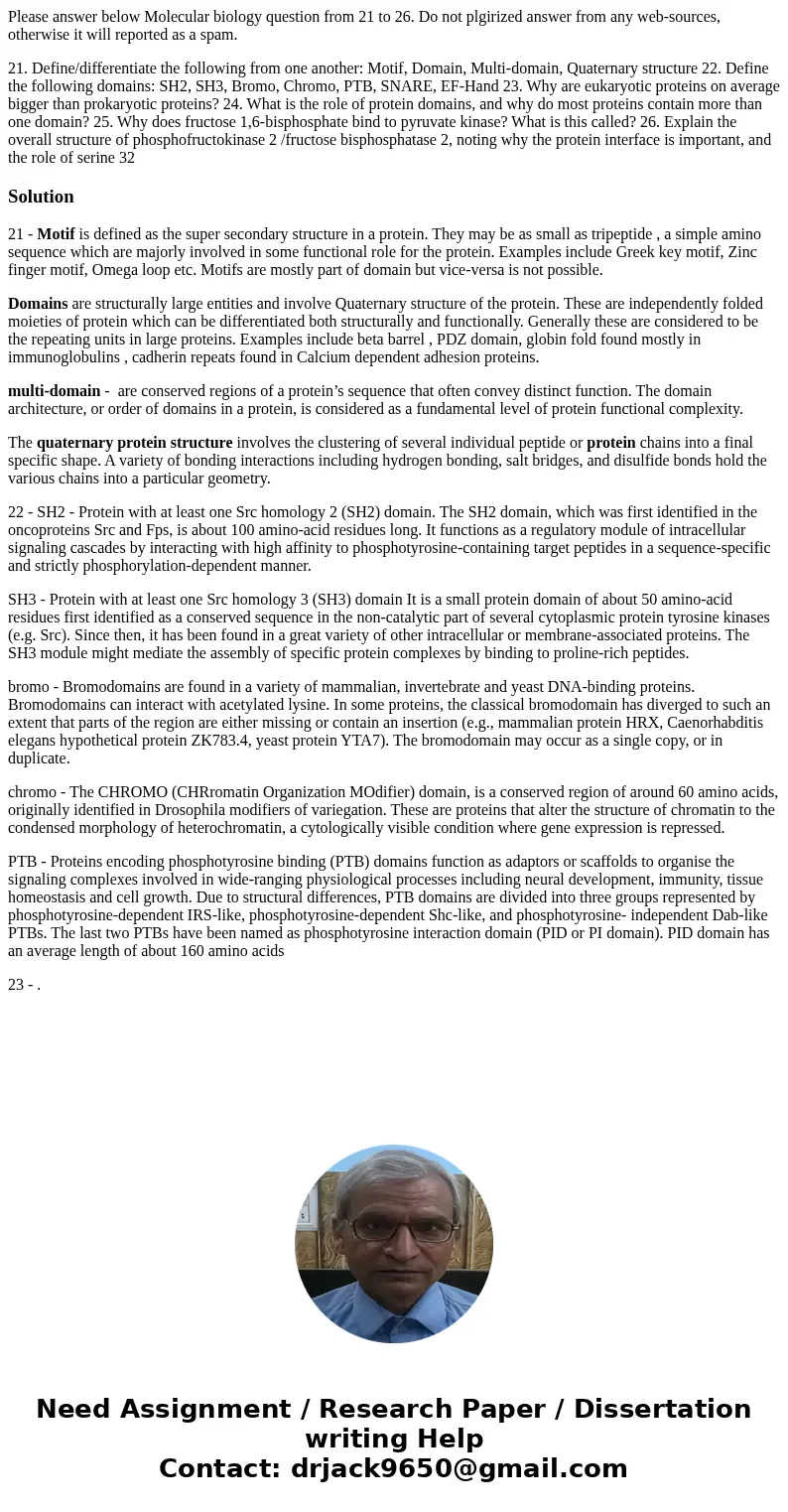Please answer below Molecular biology question from 21 to 26
Please answer below Molecular biology question from 21 to 26. Do not plgirized answer from any web-sources, otherwise it will reported as a spam.
21. Define/differentiate the following from one another: Motif, Domain, Multi-domain, Quaternary structure 22. Define the following domains: SH2, SH3, Bromo, Chromo, PTB, SNARE, EF-Hand 23. Why are eukaryotic proteins on average bigger than prokaryotic proteins? 24. What is the role of protein domains, and why do most proteins contain more than one domain? 25. Why does fructose 1,6-bisphosphate bind to pyruvate kinase? What is this called? 26. Explain the overall structure of phosphofructokinase 2 /fructose bisphosphatase 2, noting why the protein interface is important, and the role of serine 32Solution
21 - Motif is defined as the super secondary structure in a protein. They may be as small as tripeptide , a simple amino sequence which are majorly involved in some functional role for the protein. Examples include Greek key motif, Zinc finger motif, Omega loop etc. Motifs are mostly part of domain but vice-versa is not possible.
Domains are structurally large entities and involve Quaternary structure of the protein. These are independently folded moieties of protein which can be differentiated both structurally and functionally. Generally these are considered to be the repeating units in large proteins. Examples include beta barrel , PDZ domain, globin fold found mostly in immunoglobulins , cadherin repeats found in Calcium dependent adhesion proteins.
multi-domain - are conserved regions of a protein’s sequence that often convey distinct function. The domain architecture, or order of domains in a protein, is considered as a fundamental level of protein functional complexity.
The quaternary protein structure involves the clustering of several individual peptide or protein chains into a final specific shape. A variety of bonding interactions including hydrogen bonding, salt bridges, and disulfide bonds hold the various chains into a particular geometry.
22 - SH2 - Protein with at least one Src homology 2 (SH2) domain. The SH2 domain, which was first identified in the oncoproteins Src and Fps, is about 100 amino-acid residues long. It functions as a regulatory module of intracellular signaling cascades by interacting with high affinity to phosphotyrosine-containing target peptides in a sequence-specific and strictly phosphorylation-dependent manner.
SH3 - Protein with at least one Src homology 3 (SH3) domain It is a small protein domain of about 50 amino-acid residues first identified as a conserved sequence in the non-catalytic part of several cytoplasmic protein tyrosine kinases (e.g. Src). Since then, it has been found in a great variety of other intracellular or membrane-associated proteins. The SH3 module might mediate the assembly of specific protein complexes by binding to proline-rich peptides.
bromo - Bromodomains are found in a variety of mammalian, invertebrate and yeast DNA-binding proteins. Bromodomains can interact with acetylated lysine. In some proteins, the classical bromodomain has diverged to such an extent that parts of the region are either missing or contain an insertion (e.g., mammalian protein HRX, Caenorhabditis elegans hypothetical protein ZK783.4, yeast protein YTA7). The bromodomain may occur as a single copy, or in duplicate.
chromo - The CHROMO (CHRromatin Organization MOdifier) domain, is a conserved region of around 60 amino acids, originally identified in Drosophila modifiers of variegation. These are proteins that alter the structure of chromatin to the condensed morphology of heterochromatin, a cytologically visible condition where gene expression is repressed.
PTB - Proteins encoding phosphotyrosine binding (PTB) domains function as adaptors or scaffolds to organise the signaling complexes involved in wide-ranging physiological processes including neural development, immunity, tissue homeostasis and cell growth. Due to structural differences, PTB domains are divided into three groups represented by phosphotyrosine-dependent IRS-like, phosphotyrosine-dependent Shc-like, and phosphotyrosine- independent Dab-like PTBs. The last two PTBs have been named as phosphotyrosine interaction domain (PID or PI domain). PID domain has an average length of about 160 amino acids
23 - .

 Homework Sourse
Homework Sourse